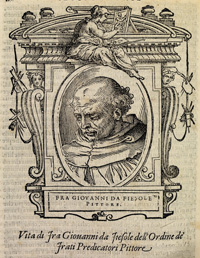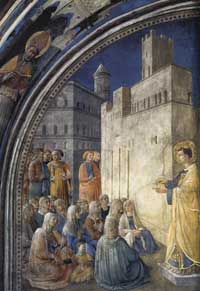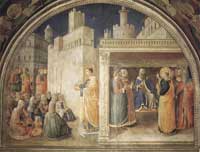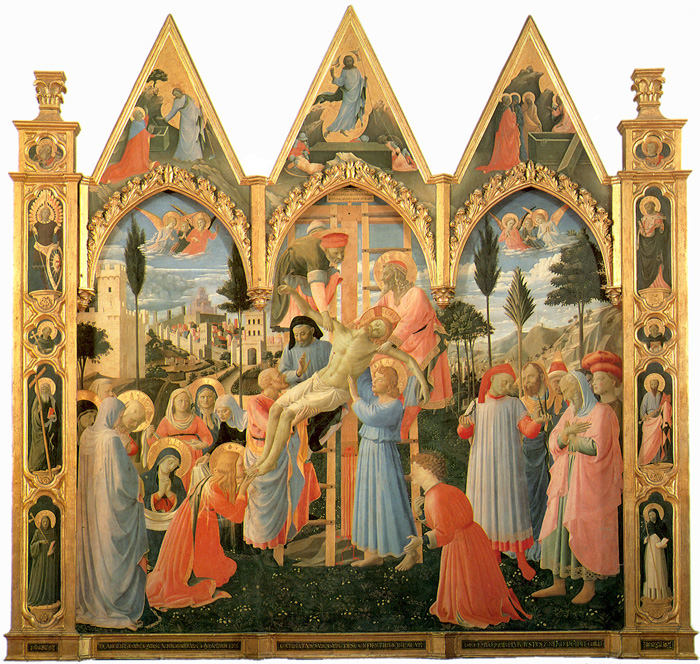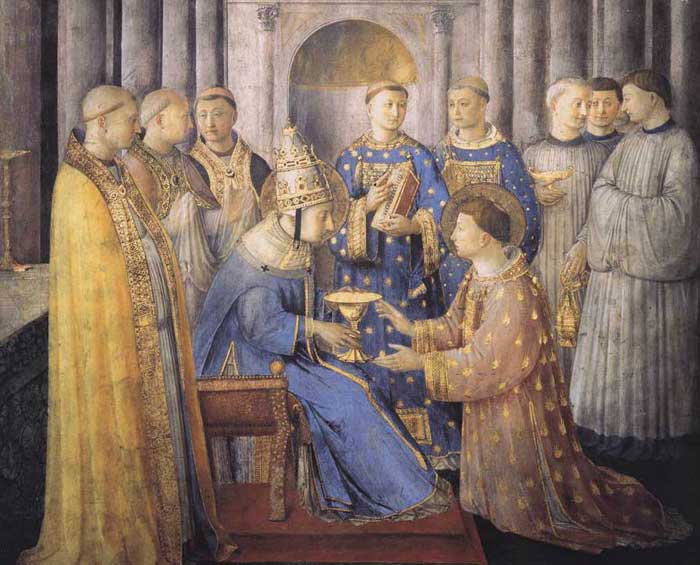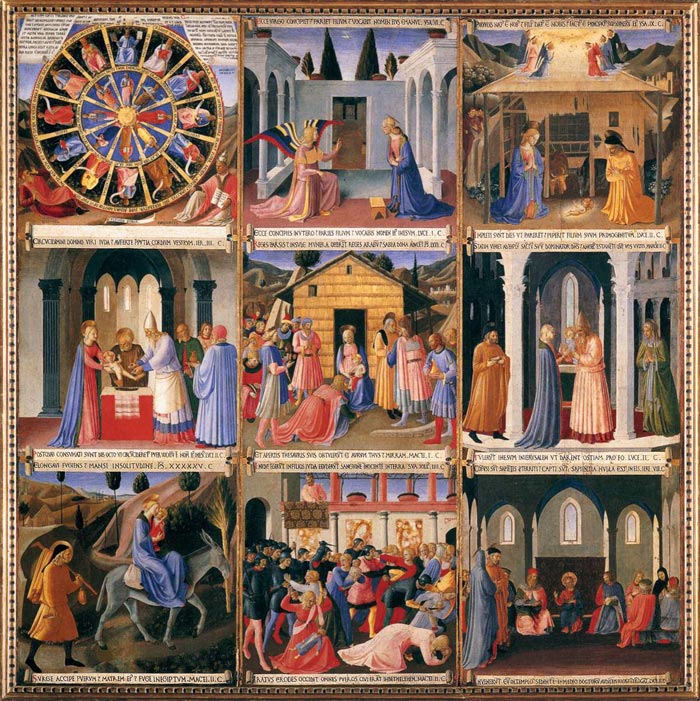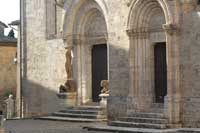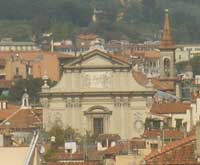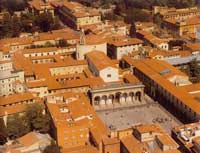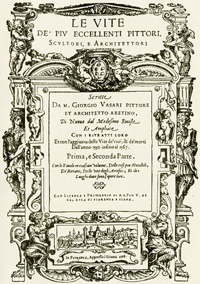 |
|
Giorgio Vasari, Fra Giovanni da Fiesole |
|
Giorgio Vasari | Lives of the Most Eminent Painters Sculptors and Architects Fra Giovanni da Fiesole |
| FRA GIOVANNI DA FIESOLE [FRA ANGELICO] PAINTER OF THE ORDER OF PREACHING FRIARS |
||
| Fra Giovanni Angelico da Fiesole, who was known in the world as Guido, was no less excellent as painter and illuminator than he was upright as churchman, and for both one and the other of these reasons he deserves that most honourable record should be made of him. This man, although he could have lived in the world with the greatest comfort, and could have gained whatever he wished, besides what he possessed, by means of those arts, of which he had a very good knowledge even in his youth, yet resolved, for his own peace and satisfaction, being by nature serious and upright, and above all in order to save his soul, to take the vows of the Order of Preaching Friars; for the reason that, although it is possible to serve God in all walks of life, nevertheless it appears to some men that they can gain salvation in monasteries better than in the world. Now in proportion as this plan succeeds happily for good men, so, on the contrary, it has a truly miserable and unhappy issue for a man who takes the vows with some other end in view. There are some choral books illuminated by the hand of Fra Giovanni in his Convent of S. Marco in Florence, so beautiful that words are not able to describe them; and similar to these are some others that he left in S. Domenico da Fiesole, wrought with incredible diligence. It is true, indeed, that in making these he was assisted by an elder brother, who was likewise an illuminator and well practised in painting. One of the first works in painting wrought by this good father was a panel in the Certosa of Florence, which was placed in the principal chapel (belonging to Cardinal Acciaiuoli); in which panel is a Madonna with the Child in her arms, and with certain very beautiful angels at her feet, sounding instruments and singing; at the sides are S. Laurence, S. Mary Magdalene, S. Zanobi, and S. Benedict; and in the predella are little stories of these Saints, wrought in little figures with infinite diligence. |
||
In the cross of the said chapel are two other panels by the hand of the same man; one containing the Coronation of Our Lady, and the other a Madonna with two saints, wrought with most beautiful ultramarine blues. Afterwards, in the tramezzo of S. Maria Novella, beside the door opposite to the choir, he painted in fresco S. Dominic, S. Catherine of Siena, and S. Peter Martyr; and some little scenes in the Chapel of the Coronation of Our Lady in the said tramezzo. On canvas, fixed to the doors that closed the old organ, he painted an Annunciation, which is now in the convent, opposite to the door of the lower dormitory, between one cloister and the other. |
||
 |
||
Fra Angelico, Transfiguration , 1440-42, fresco, 181 x 152 cm, Convento di San Marco (Cell 6), Florence |
||
Over a door of the cloister of the Badia in the same city he painted a S. Benedict, who is making a sign enjoining silence. For the Linen-manufacturers he painted a panel that is in the Office of their Guild; and in Cortona he painted a little arch over the door of the church of his Order, and likewise the panel of the high-altar. At Orvieto, on a part of the vaulting of the Chapel of the Madonna in the Duomo, he began certain prophets, which were finished afterwards by Luca da Cortona. For the Company of the Temple in Florence he painted a Dead Christ on a panel; and in the Church of the Monks of the Angeli he made a Paradise and a Hell with little figures, wherein he showed fine judgment by making the blessed very beautiful and full of jubilation and celestial gladness, and the damned all ready for the pains of Hell, in various most woeful attitudes, and bearing the stamp of their sins and unworthiness on their faces. The blessed are seen entering the gate of Paradise in celestial dance, and the damned are being dragged by demons to the eternal pains of Hell. This work is in the aforesaid church, on the right hand as one goes towards the high-altar, where the priest sits when Mass is sung. For the Nuns of S. Piero Martire—who now live in the Monastery of S. Felice in Piazza, which used to belong to the Order of Camaldoli—he painted a panel with Our Lady, S. John the Baptist, S. Dominic, S. Thomas, and S. Peter Martyr, and a number of little figures. And in the tramezzo of S. Maria Nuova there may also be seen a panel by his hand. |
||
The Sermon of St Stephen, 1447-49 |
||
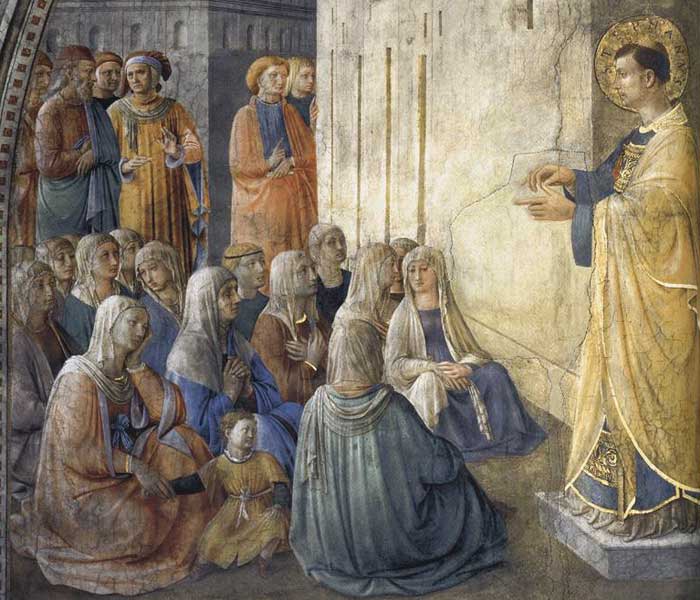 |
||
The Sermon of St Stephen, 1447-49, fresco, Cappella Niccolina, Palazzi Pontifici, Vatican |
||
Great excellence was that of Fra Giovanni, and a thing truly very rare, to resign a dignity and honour and charge so important, offered to himself by a Supreme Pontiff, in favour of the man whom he, with his singleness of eye and sincerity of heart, judged to be much more worthy of it than himself. Let the churchmen of our own times learn from this holy man not to take upon themselves charges that they cannot worthily carry out, and to yield them to those who are most worthy of them. Would to God, to return to Fra Giovanni (and may this be said without offence to the upright among them), that all churchmen would spend their time as did this truly angelic father, seeing that he spent every minute of his life in the service of God and in benefiting both the world and his neighbour. And what can or ought to be desired more than to gain the kingdom of Heaven by living a life of holiness, and to win eternal fame in the world by labouring virtuously? And in truth a talent so extraordinary and so supreme as that of Fra Giovanni could not and should not descend on any save a man of most holy life, for the reason that those who work at religious and holy subjects should be religious and holy men; for it is seen, when such works are executed by persons of little faith who have little esteem for religion, that they often arouse in men's minds evil appetites and licentious desires; whence there comes blame for the evil in their works, with praise for the art and ability that they show. Now I would not have any man deceive himself by considering the rude and inept as holy, and the beautiful and excellent as licentious; as some do, who, seeing figures of women or of youths adorned with loveliness and beauty beyond the ordinary, straightway censure them and judge them licentious, not perceiving that they are very wrong to condemn the good judgment of the painter, who holds the Saints, both male and female, who are celestial, to be as much more beautiful than mortal man as Heaven is superior to earthly beauty and to the works of human hands; and, what is worse, they reveal the unsoundness and corruption of their own minds by drawing evil and impure desires out of works from which, if they were lovers of purity, as they seek by their misguided zeal to prove themselves to be, they would gain a desire to attain to Heaven and to make themselves acceptable to the Creator of all things, in whom, as most perfect and most beautiful, all perfection and beauty have their source. What would such men do if they found themselves, or rather, what are we to believe that they do when they actually find themselves, in places containing living beauty, accompanied by licentious ways, honey-sweet words, movements full of grace, and eyes that ravish all but the stoutest of hearts, if the very image of beauty, nay, its mere shadow, moves them so profoundly? However, I would not have any believe that I approve of those figures that are painted in churches in a state of almost complete nudity, for in these cases it is seen that the painter has not shown the consideration that was due to the place; because, even although a man has to show how much he knows, he should proceed with due regard for circumstances and pay respect to persons, times, and places. |
||
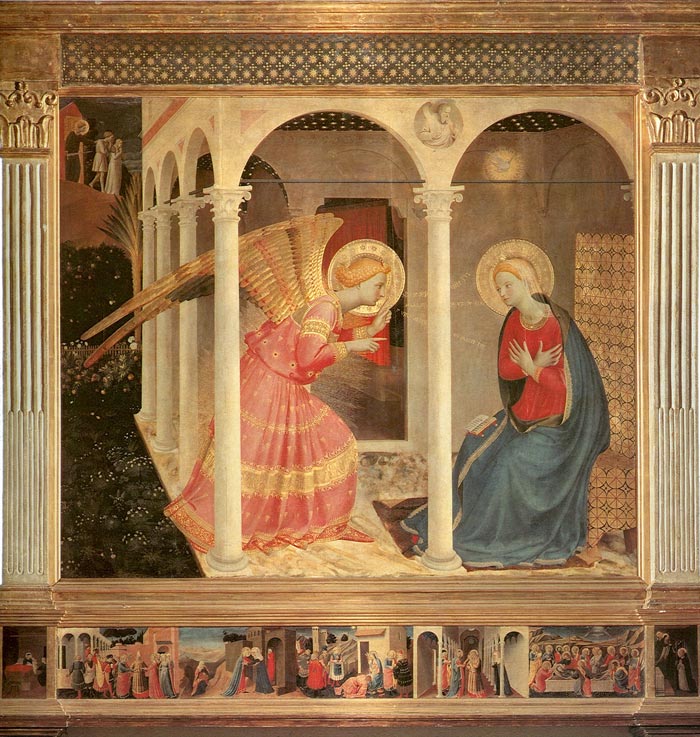 |
||
Fra Angelico, Annunciation, c. 1432-1434, tempera on panel, Cortona, Museo Diocesano
|
||
He died in 1455 at the age of sixty-eight, and left disciples in Benozzo, a Florentine, who ever imitated his manner, and Zanobi Strozzi, who painted pictures and panels throughout all Florence for the houses of citizens, and particularly a panel that is now in the tramezzo[8] of S. Maria Novella, beside that by Fra Giovanni, and one in S. Benedetto, a monastery of the Monks of Camaldoli without the Porta a Pinti, now in ruins. The latter panel is at present in the little Church of S. Michele in the Monastery of the Angeli, before one enters the principal church, set up against the wall on the right as one approaches the altar. There is also a panel in the Chapel of the Nasi in S. Lucia, and another in S. Romeo; and in the guardaroba of the Duke there is the portrait of Giovanni di Bicci de' Medici, with that of Bartolommeo Valori, in one and the same picture by the hand of the same man. Another disciple of Fra Giovanni was Gentile da Fabriano, as was also Domenico di Michelino, who painted the panel for the altar of S. Zanobi in S. Apollinare at Florence, and many other pictures. Fra Giovanni was buried by his fellow-friars in the Minerva in Rome, near the lateral door beside the sacristy, in a round tomb of marble, with himself, portrayed from nature, lying thereon. The following epitaph may be read, carved in the marble: NON MIHI SIT LAUDI, QUOD ERAM VELUT ALTER APELLES, In S. Maria del Fiore are two very large books illuminated divinely well by the hand of Fra Giovanni, which are held in great veneration and richly adorned, nor are they ever seen save on days of the highest solemnity. |
||
|
||
Fiesole Triptych (San Domenico Altarpiece), 1424-1430 |
||
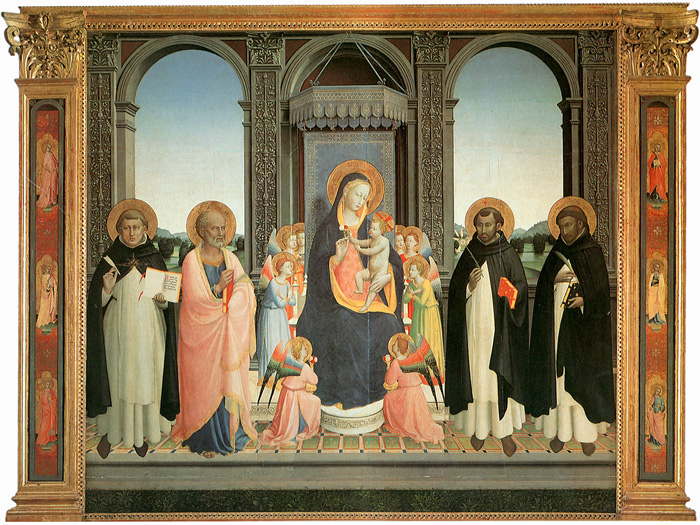 |
||
Fra Angelico, Fiesole Triptych, 1424-1430, tempera on panel, 212 x 237cm, Fiesole, San Domenico |
||
|
||
Coronation of the Virgin, c. 1434-1345 |
||
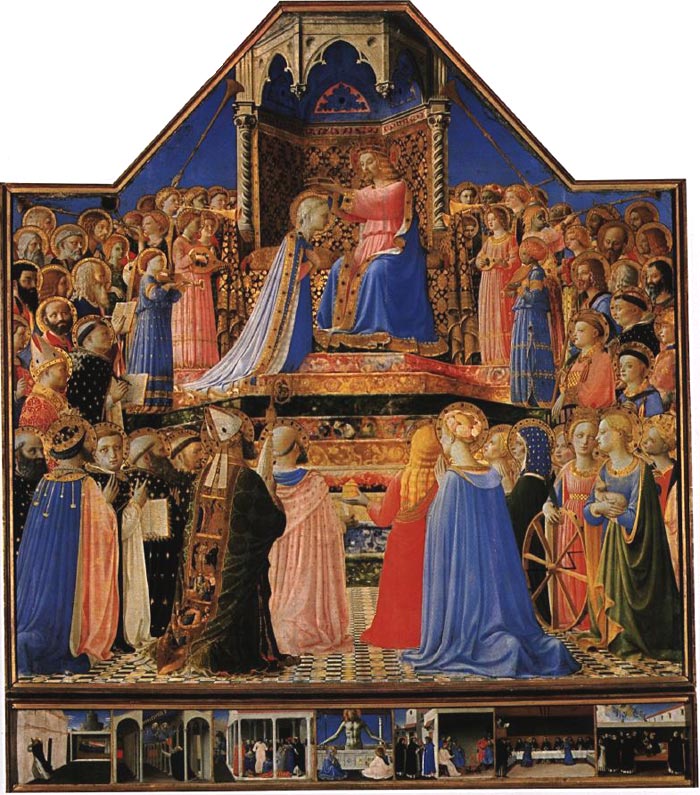 |
||
Fra Angelico, Coronation of the Virgin, c. 1434-1345, tempera on panel, 213 x 211 cm, Paris, Musee du Louvre |
||
|
||
Santa Trinità Altarpiece (1437-40) |
||
Fra Angelico, Deposition from the Cross (Pala di Santa Trinità), 1437-40, Museo di San Marco, Florence |
||
|
||
Last Judgement (c. 1431) |
||
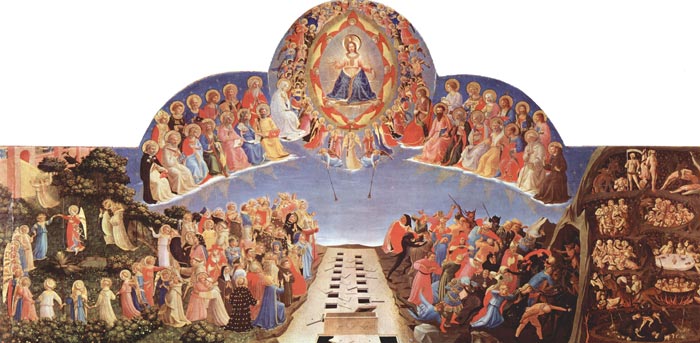 |
||
Fra Angelico, Last Judgement, c. 1431, tempera on panel, 105 x 210 cm, Museo di San Marco, Florence |
||
|
||
Frescoes in the Convento di San Marco (1438-50) |
||
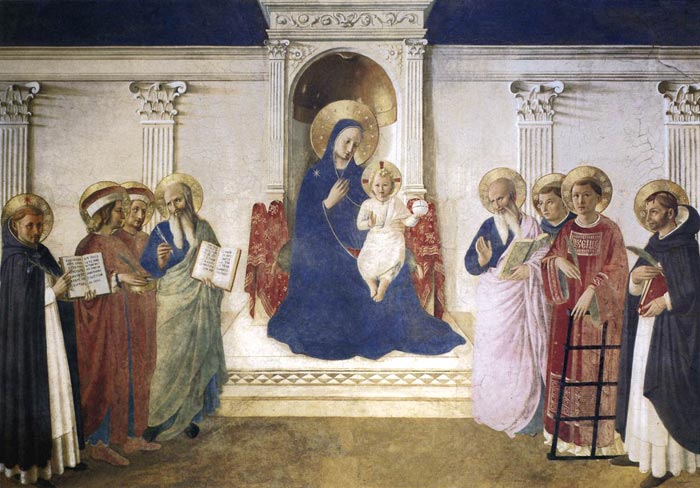 |
||
Fra Angelico, Sacra Conversazione, c. 1443, fresco, 195 x 273 cm, Convento di San Marco, Florence |
||
|
||
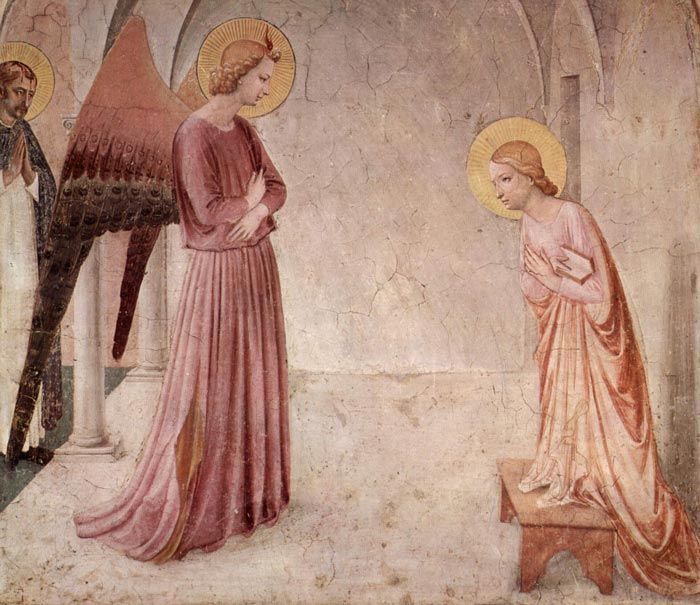 |
||
Fra Angelico, Annunciation (Cell 3), 1440-42, fresco, 176 x 148 cm, Convento di San Marco, Florence |
||
|
||
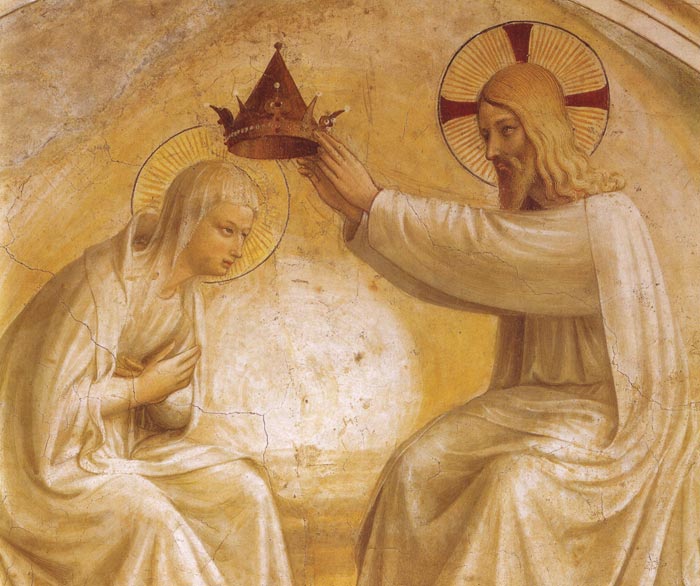 |
||
Fra Angelico, Coronation of the Virgin (Cell 9), 1440-42, fresco, 171 x 151 cm, Convento di San Marco, Florence |
||
|
||
Frescoes in the Cappella Niccolina of the Palazzi Pontifici in Vatican (1447-49) |
||
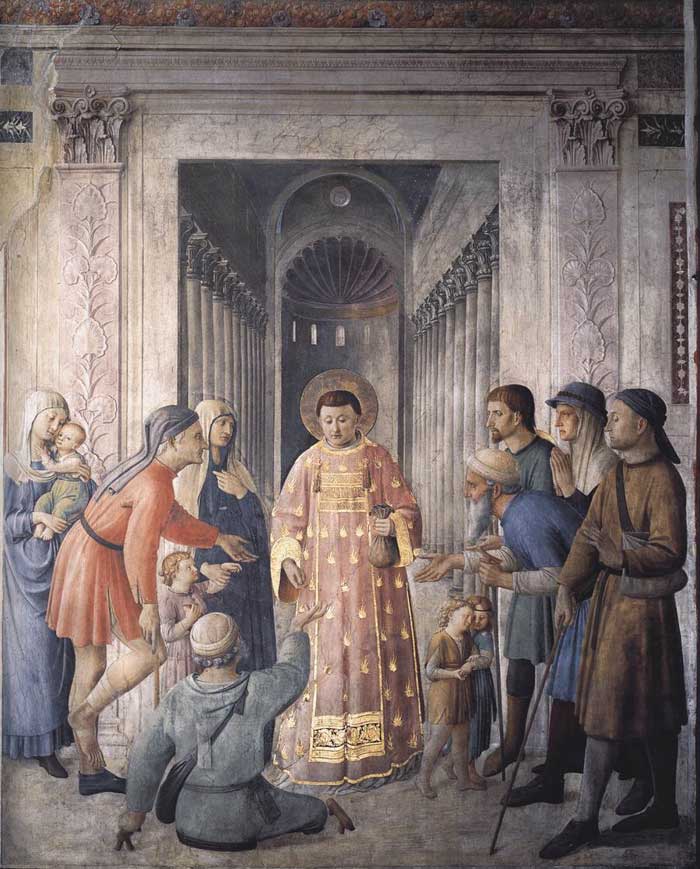 |
||
Fra Angelico, St Lawrence Distributing Alms, 1447–1449, fresco, Cappella Niccolina, Vatican Palace, Vatican City |
||
|
||
Fra Angelico, St. Peter Consecrates St. Laurence as Deacon, 1447–1449, fresco, Cappella Niccolina, Vatican Palace, Vatican City |
||
Paintings for the Armadio degli Argenti (1451-52) | Scenes from the Life of Christ |
||
Fra Angelico, Scenes from the Life of Christ, 1451-52, tempera on panel, 39 x 39 cm, Museo di San Marco, Florence |
||
|
||
Mystic Wheel (The Vision of Ezekiel) |
||
 |
||
Fra Angelico, Mystic Wheel (The Vision of Ezekiel), Scenes from the Life of Christ, 1451-52, tempera on panel, 39 x 39 cm, Museo di San Marco, Florence |
||
Art in Tuscany | Art in Tuscany | Giorgio Vasari | Lives of the Most Excellent Painters, Sculptors, and Architects |
||||
|
Art in Tuscany | Fra Angelico |
||||
Holiday accomodation in Tuscany | Podere Santa Pia | Artist and writer's residency |
||||
Podere Santa Pia |
Podere Santa Pia, garden view, April |
View from Podere Santa Pia
on the coast and Corsica |
||
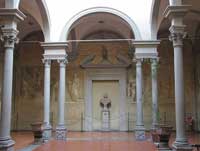 |
||||
San Qurico d'Orcia |
Piazza della Santissima Annunziata in Florence |
Choistro dello Scalzo, Florence |
||
The façade and the bell tower of San Marco in Florence |
Piazza della Santissima Annunziata in Florence |
Florence, Duomo |
||
| Giorgio Vasari (Arezzo, 30 luglio 1511 – Firenze, 27 giugno 1574) was an Italian painter and architect, mainly known for his famous biographies of Italian artists. At a very early age he became a pupil of Guglielmo da Marsiglia, a very skilful painter of stained glass, to whom he was recommended by his own kinsman, the painter Luca Signorelli. At the age of sixteen Cardinal Silvio Passerini who sent him to study in Florence, in the circle of Andrea del Sarto and his pupils Rosso and Jacopo Pontormo. His humanist education was not ignored, and he met and knew Michelangelo, whose painting style influenced Vasari's. In 1529 he visited Rome and studied the works of Raphael and others of the Roman High Renaissance of the previous generation. Vasari's own Mannerist paintings were more admired in his lifetime than afterwards. He was consistently employed by patrons in the Medici family in Florence and Rome, and he worked in Naples, Arezzo and other places. Many of his pictures still exist, the most important being the wall and ceiling paintings in the great hall of the Palazzo Vecchio in Florence, and his broad, uncompleted frescoes inside the dome of the Florentine Duomo. As an architect he was perhaps more successful: the loggia of the Palazzo degli Uffizi by the Arno, the urbanistic planning of its long narrow courtyard that functions as a public piazza, and the long passage connecting it with the Pitti Palace, through Ponte Vecchio, are his chief work. He worked with with Giacomo Vignola and Bartolomeo Ammanati at the Villa di Papa Giulio ("[[Villia Giulia") in Rome. Unhappily he did much to injure the fine medieval churches of Santa Maria Novella and Santa Croce, from both of which he removed the original rood-screen and loft, and remodelled the retro-choir in the Mannerist taste of his time. Vasari enjoyed a very high repute during his lifetime and amassed a considerable fortune. He built himself in 1547 a fine house in Arezzo (now a museum honoring him), and spent much labour in decorating its walls and vaults with paintings. He was elected one of the municipal council or priori of his native town, and finally rose to the supreme office of gonfaloniere. In 1563 he founded the Accademia del Disegno at Florence, with the Grand Duke and Michelangelo as capi of the institution and thirty-six artists chosen for members. He died at Florence on June 27, 1571. The Vite |
||||

